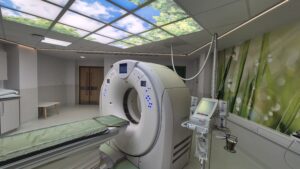Region’s community diagnostic centres offer one-stop-shops for checks, scans and tests
Almost 900,000 tests, checks and scans have been delivered in NHS community diagnostic centres (CDCs) across the North East and Yorkshire in the past 12 months alone, NHS figures show. In total, the region’s CDCs have carried out 1.6 million diagnostic procedures since the introduction of the national initiative.
Located in community settings such as shopping centres, high streets and retail centres, NHS community diagnostic centres offer patients a wide range of health tests closer to home. CDCs deliver checks, tests and diagnostics including:
- Imaging services including MRI, CT scans and X-rays,
- Cardiovascular tests such as ECGs and blood pressure monitoring,
- Blood tests to detect infections, metabolic disorders and diseases such as diabetes,
- Respiratory tests for asthma and chronic obstructive pulmonary disease (COPD),
- Early screening for conditions such as bowel, breast, and prostate cancers.
Community diagnostic centres also give patients greater choice on where and how their tests are carried out, reducing the need for hospital visits and shortening waiting times. Appointments are made following a referral by the patient’s GP, other clinician, or a screening invitation letter, and many CDCs offer weekend appointments as well as extended weekday opening.
“Community diagnostic centres provide patients with a set of tests in the heart of local communities, in as few visits as possible, which enables an accurate and fast diagnosis for a wide range of health issues,” explained Dr Hamish McLure, NHS Regional Medical Director for the North East and Yorkshire.
 “By providing a broad range of tests in accessible community locations, CDCs reduce pressure on hospitals and give patients quicker and more convenient access to the tests they need. Furthermore, all the diagnostic tests a patient needs can be coordinated by the centre and, wherever possible, will be provided in a single visit.”
“By providing a broad range of tests in accessible community locations, CDCs reduce pressure on hospitals and give patients quicker and more convenient access to the tests they need. Furthermore, all the diagnostic tests a patient needs can be coordinated by the centre and, wherever possible, will be provided in a single visit.”
By providing multiple tests at one visit, reducing the number of patient journeys and helping to cut carbon emissions and air pollution, community diagnostic centres also contribute to the NHS’s net zero ambitions.
CDCs in the North East include:
- The Community Diagnostic Centre in the Metrocentre offers checks, scans and tests outside the main hospital. It is a collaboration between Newcastle Hospitals and Gateshead Health,
- Tees Valley Community Diagnostic Centre at Stockton-on-Tees offers rapid scans, tests and checks for a number of health issues,
- Opening this summer in the town centre, Workington’s CDC will offer MRI, CT and ultrasound scanning for patients across north Cumbria.
CDCs across Yorkshire include:
- Wakefield Community Diagnostic Centre (CDC) at Westgate Retail Park.
- York CDC at Askham Bar Community Care Centre,
- Located in the Glass Works shopping centre Barnsley CDC (pictured) offers testing and screening in a modern, convenient location,
 The Montagu Community Diagnostic Centre in Mexborough provides a broad range of checks, scans, and tests in a convenient location,
The Montagu Community Diagnostic Centre in Mexborough provides a broad range of checks, scans, and tests in a convenient location,- Diagnostic centres at Scunthorpe and Grimsby open this spring and are set to deliver 146,000 tests every year to detect cancer, heart disease and respiratory conditions.
- The CDC in central Halifax provides x-rays, ultrasounds, CT, and MRI scans, as well as other diagnostic testing including blood pressure and heart monitoring.
Dr McLure said by giving members of the public a comprehensive range of diagnostic services, CDCs are key in the early detection of disease and timely treatment – bringing about an overall improvement in healthcare.
He added: “The roll-out of community diagnostic centres across the North East and Yorkshire and other regions is bringing about a step-change in delivering frontline NHS services to patients.
“The centres enable more joined-up care across primary, community and secondary care settings and, by streamlining the way the NHS provides acute and planned diagnostic services, improve the service delivered to patients.”
